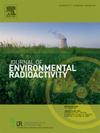直接测量加蓬三个城市的室内钍和氡后代并估算吸入剂量:使用典型钍和测量平衡因子值的比较。
IF 1.9
3区 环境科学与生态学
Q3 ENVIRONMENTAL SCIENCES
引用次数: 0
摘要
这项研究的重点是在加蓬的弗朗斯维尔、莫安达和穆纳纳,公众因吸入氡和钍的后代而受到天然放射性的照射。通过实验确定了钍及其后代之间的平衡因子(FTn),以正确估算有效剂量。为了评估氡和钍原的内照射,在上述城镇部署了 150 个被动氡-钍鉴别探测器(RADUET)和钍原监测器,为期约 3 个月。测量结果显示,弗朗斯维尔、莫安达和穆纳纳的钍原平均浓度(EETC)分别为 1.54 ± 0.08 Bq m-3、3.05 ± 0.09 Bq m-3 和 1.84 ± 0.11 Bq m-3。在弗朗斯维尔、莫安达和穆纳纳,测得的钍平衡因子范围分别为 0.004-0.710、0.005-0.750 和 0.006-0.794。算术平均值和几何平均值分别为:弗朗斯维尔 0.183 和 0.117,莫安达 0.184 和 0.122,穆纳纳 0.221 和 0.140。通过实验确定的平衡因子(FTnexp),我们可以将实验确定的有效剂量值与使用联合国原子辐射影响问题科学委员会(UNSCEAR)2000 年报告提出的平衡因子计算得出的理论确定值进行比较。FTnexp 值约为 UNSCEAR 典型值的 6-11 倍。确定的 EERC 值范围、算术平均值和几何平均值分别为:弗朗斯维尔 30.40-55.60 Bq m-3、24.00 ± 0.90 Bq m-3 和 41.68 (1.00);莫安达 36.40-62.50 Bq m-3、45.30 ± 0.70 Bq m-3 和 44.72 (1.00);穆纳纳 35.00-90.00 Bq m-3、50.00 ± 2.00 Bq m-3 和 48.50 (1.00)。在弗朗斯维尔、莫安达和穆纳纳,使用 FTnexp 测定的托龙后代年有效吸入剂量的平均值分别为 0.32 mSv(相比之下为 0.049 mSv)、0.63 mSv(相比之下为 0.103 mSv)和 0.39 mSv(相比之下为 0.055 mSv)。本研究的主要结论是,间接估算的荆棘子代浓度大大低估了年度有效吸入剂量的估算值。本文章由计算机程序翻译,如有差异,请以英文原文为准。
Direct measurement of indoor thoron and radon progeny and estimation of inhalation dose in three cities in Gabon: Comparison of the use of thoron typical and measured equilibrium factor values
This study focuses on public exposure to natural radioactivity caused by the inhalation of radon and thoron progeny in homes in Franceville, Moanda and Mounana in Gabon. The equilibrium factor (FTn) between thoron and its progeny was determined experimentally for a proper estimate of the effective dose. In order to assess internal exposure due to radon and thoron progeny, 150 passive radon-thoron discriminative detectors (RADUET) and thoron progeny monitors were deployed for about 3 months in the above-mentioned towns. The results of the measurements obtained showed that the average concentrations of thoron progeny (EETC) were 1.54 ± 0.08 Bq m−3, 3.05 ± 0.09 Bq m−3 and 1.84 ± 0.11 Bq m−3 in Franceville, Moanda and Mounana, respectively. The ranges of the measured thoron equilibrium factors were 0.004–0.710, 0.005–0.750, and 0.006–0.794 in Franceville, Moanda and Mounana, respectively. The arithmetic and geometric mean values were, respectively, 0.183 and 0.117 in Franceville, 0.184 and 0.122 in Moanda, and 0.221 and 0.140 in Mounana. The experimentally determined equilibrium factor (FTnexp) allowed us to compare the value of the experimentally determined effective dose with the theoretically determined one calculated using the equilibrium factor proposed by United Nation Scientific Committee on the Effects of Atomic Radiation (UNSCEAR) 2000 report. FTnexp values were around 6–11 times greater than the UNSCEAR typical value. The ranges, arithmetic and geometric mean EERC values determined were 30.40–55.60 Bq m−3, 24.00 ± 0.90 Bq m−3 and 41.68 (1.00) in Franceville, 36.40–62.50 Bq m−3, 45.30 ± 0.70 Bq m−3 and 44.72 (1.00) in Moanda, and 35.00–90.00 Bq m−3, 50.00 ± 2.00 Bq m−3 and 48.50 (1.00) in Mounana. The mean values of the annual effective inhalation dose due to thoron progeny determined using FTnexp were 0.32 mSv (compared to 0.049 mSv), 0.63 mSv (compared to 0.103 mSv), and 0.39 mSv (compared to 0.055 mSv) in Franceville, Moanda and Mounana, respectively. The main conclusion of this study is that indirect estimations of thoron progeny concentrations considerably underestimate the estimation of the annual effective inhalation dose.
求助全文
通过发布文献求助,成功后即可免费获取论文全文。
去求助
来源期刊

Journal of environmental radioactivity
环境科学-环境科学
CiteScore
4.70
自引率
13.00%
发文量
209
审稿时长
73 days
期刊介绍:
The Journal of Environmental Radioactivity provides a coherent international forum for publication of original research or review papers on any aspect of the occurrence of radioactivity in natural systems.
Relevant subject areas range from applications of environmental radionuclides as mechanistic or timescale tracers of natural processes to assessments of the radioecological or radiological effects of ambient radioactivity. Papers deal with naturally occurring nuclides or with those created and released by man through nuclear weapons manufacture and testing, energy production, fuel-cycle technology, etc. Reports on radioactivity in the oceans, sediments, rivers, lakes, groundwaters, soils, atmosphere and all divisions of the biosphere are welcomed, but these should not simply be of a monitoring nature unless the data are particularly innovative.
 求助内容:
求助内容: 应助结果提醒方式:
应助结果提醒方式:


